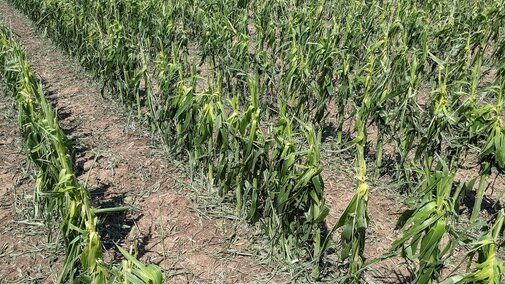Wheat Straw Use Values
Wheat straw marketing may provide added value for wheat growers following grain harvest. Response to drought and tight forage supplies have increased demand for straw and baled forages. Current hay markets are posting average large round straw bale values of $58 per bale with large square bales pegging $64 each. Small wheat straw bales are also selling strong. Despite these price trends, is selling wheat straw from your fields a good decision for your farm?
Your first consideration is whether you have equipment available to windrow and bale wheat straw. Combines, which use wheat head strippers or forage choppers, may not allow straw windrowing. Secondly, do both the short-term and long-term opportunity costs of exporting nutrients and carbon away from your fields make financial sense?
Baling wheat straw windrows behind combines will usually leave about half the residue in the remaining 6-12-inch standing stubble, so the baled wheat straw will only remove about 1-2 tons of straw per acre with nutrient content of 12 pounds nitrogen; 3.5 pounds phosphorus; and 25 pounds potassium per ton of residue removed, the potential nutrient removal value will range from $15 to $30 per acre for successive crops. Secondary and micronutrients may also be removed with the straw, but their value will be low.
A final consideration might be the organic carbon losses through straw removal. Unlike nutrients, which might be easily replaced through commercial fertilizers, carbon replacement may be more challenging. Adding manures and cover crops can replace straw nutrient and carbon removal and likely improve soil organic matter content, water infiltration and soil water holding capacity, plus reduce soil erosion.
For long-term best management, focus on maintaining soil organic matter by rotating straw harvested fields and applying manure for carbon replacement.
Grazing Summer Annual Forage
Summer annual forages such as sudangrass, sorghum-sudan hybrids and pearl millet planted this spring soon could be ready to graze. There are some grazing guidelines to help avoid potential hazards.
The first guideline is to never turn hungry animals into sudangrass or sorghum-type pastures. The reason why is because they may eat so rapidly that they could get a quick overdose of prussic acid and die. All sudangrass and sorghum-type hybrids can produce a compound called prussic acid that is potentially poisonous. Prussic acid — which also is called cyanide — is nothing to fear though, as long as you use a few precautions to avoid problems.
The highest concentration of prussic acid is in new young shoots, so let your grass get a little growth on it before grazing to help dilute out the prussic acid. Let sudangrass get 15 to 18 inches in height before grazing. Sorghum-sudan hybrids usually have a little more prussic acid risk, so wait until they are 18 to 24 inches tall.
Pearl millet does not contain prussic acid, so if you planted millet these grazing precautions aren’t needed. Pearl millet can be grazed when it reaches 12 to 15 inches tall.
Nitrates also can accumulate in these grasses, particularly when there may be drought conditions and/or excess nitrogen fertilization. However, as long as you avoid grazing too short, nitrates should not be a problem.
Summer annual grasses respond best to a simple, rotational grazing system. Divide fields into three or more smaller paddocks of a size that your animals can graze down to about eight or so inches of leafy stubble within seven to 10 days. Repeat this procedure with all paddocks. If grass in some paddocks gets too tall, it could be cut for hay.
A well-planned start, a good rotation and a little rain can give you good pasture from these grasses all the rest of the summer.
Decisions After Wind, Hail Damage to Crops
By Brad Schick
Wondering what to do with severely damaged corn or soybeans after wind and hail? What are some good options?
With severe storms bringing wind and hail, planting another crop or forage may be an option for those impacted to consider, especially with a good chunk of summer growing still ahead. Take into consideration lost residue for winter grazing if still taken for grain. Before any decisions are made, contact your crop insurance agent to make sure things are done correctly. While damage may look bad on corn and soybeans, it is recommended to wait seven to 10 days before assessing your crop damage to allow time for the plants to recover. Visit CropWatch’s Hail Know site for some additional resources.
If grazed or hayed forages are needed this year, a summer or a cool-season annual could be planted and perform well. Be sure to check the label of the herbicides applied to the corn or soybeans, as some have limitations or could damage the annual forage crop. Previously applied herbicides generally affect millets more than sundangrass, forage sorghum or sorghum-sudangrass hybrids. These summer annuals can usually be grazed, hayed, chopped, windrow grazed or stockpiled for winter. If grazing, be sure to take appropriate precautions to prevent issues with nitrates in stressed plants and prussic acid in sorghum species.
If a later forage option is wanted, oats and a brassica such as rapeseed should be considered. Planting for these cool-season species should wait until early August, which is still a long way off. If grazing, make sure cattle are turned out full and with plenty of fresh water available to reduce the chance of bloat from these high-quality forages. Another benefit of these later plantings is suppression of our winter and spring annual weeds.
There are many forage options available to fill in behind storm damaged crops. Be sure to doublecheck your herbicide label for restrictions before selecting a species and before anything is done, contact your crop insurance agent to make sure things are done in compliance.

